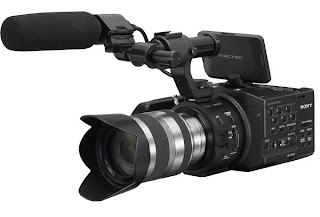RED was at the ICG 600 Mega-Digital event for the first time with a mini-training session for the Epic. It's fun to sit in a session with DP's, operators, assistants and DIT's, each with their own concerns and questions. Not only did we have a chance to shoot with the Epic (the Epic is the one with hump) but question them about the upcoming Scarlet (no hump).
As you might remember, the Scarlet was supposed to have 2/3" chips but the popularity of the large sensor DSLR made that camera obsolete before it was manufactured. Instead, RED was testing a batch of Epic sensors, found some too slow for 5K and are using these "rated" chips for the 4K Scarlet.
Speaking of speed, it's slow... for today's cameras. The original RED One was really slow but a couple of years ago RED came up with the MX chip. The Epic/Scarlet is as fast as the MX with a top floor of 800ASA but everything above that is noisy plus now the other manufacturers, notably Canon, are much faster.
And while we're looking at the front you can see what audio types will hate, the two unbalanced mini-plugs. That's the only audio ports on the camera.
The biggest advantage of the Epic/Scarlet is 5K/4K resolution but who's using it or asking for it? Unless you're shooting features you're delivering 1920x1080 for broadcast and less for the internet. .r3d files are huge, the SSD cards and associated hardware is expensive and transcoding those files can literally take days. Seriously. I've heard of people easily shooting 200MB to 1TB a day. This requires some kind of full time data wrangler.
If you use the raw .r3d files, everything frame has to be graded and color corrected. Most producers I work with want an image then can edit with now, not something they have to transcode and grade first. Many current RED user only use the 2K proxy files to edit but these Quicktime files are not available on the Epic/Scarlet at this time.
The Epic/Scarlet can shoot higher frame rates but you pay a price: The faster the frame rate the smaller the frame size. In other words, to shoot 48fps you're at 3K, 120fps you're down to 1K which is less than 720p camera (I don't know why film types use "width" pixel count and TV types use "height" pixel count).
More important, the RED doesn't downsize, it crops, so your FOV changes as you speed up. To you that means the focal length of your lens gets longer. Go twice as fast and you effectively zoom in by 2X so you're 18mm lens becomes a 36mm, so don't think high speed and wide angle. Use HRDx and everything doubles again.
The HDRx doesn't work with motion shots. HDRx works by storing an A frame at standard exposure and an X frame exposed at a higher shutter speed at the same time. If it's a still frame, HDRx works like a charm. If you have any motion, camera or talent, you get this ghosting from the blur of the A frame. It just doesn't work. But you could use the A and X frames separately like the shot above of someone driving out of a tunnel into the sunlight.
http://www.fxguide.com/featured/hdrx-the-impossible-shot/
Finally, let's talk price. The
Epic-M package runs $58,000, definitely Alexa territory. But unlike the Alexa you get everything you need to shoot, except AC adapter. The
Scarlet body starts at $9750 but you don't even get a viewfinder. RED sells a basic package is $14,015-15,515 depending on mount. And this is a very basic package, just enough to shoot. .r3d uses lots of memory so you'll need more than one SSD and each 128GB RedMag is $1800 bucks a piece. Even this basic Scarlet package price doesn't even include a viewfinder and, of course, no glass.
Speaking of lenses, the Scarlet come in four flavors: You can get an Aluminum (Al) mount or, for those who swap lenses constantly, a Titanium (Ti) mount and either of these can be for PL or Canon EF lenses.
RED has realized that many lower end/Scarlet type users aren't going to want to spend tens of thousands on glass and has made using Canon EF glass easy. The
DSMC Side Handle has all the dials and buttons a DSLR user is familiar with and makes it easy to adjust f-stop and go through menus.
Design wise, RED has really thought out the design of the camera (besides audio) and I'd really like to buy American but is it what producers are looking for with all the other cameras in the market?
Here's what Philip Bloom has to say about the Epic/Scarlet:
http://philipbloom.net/2011/11/20/scarlet/
I wrote this a month ago as I was still collecting information. Now, there's a new development:
http://philipbloom.net/2011/12/10/nomoreepic/




















































